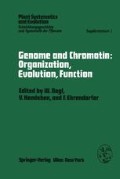Abstract
Reduction of the nuclear DNA amount in a constant number of n = 9 chromosomes characterizes the evolutionary genetics of the genus Microseris. Correlated with this reduction are physiological, ecological and morphological changes. The morphological changes are of two kinds: (1) nucleotypic, i.e. changes in the dimensions correlated with DNA amount changes; (2) qualitative, specifically concerning an increase in the degree of developmental canalization with a decrease in genome size. The latter changes are amenable to formal genetic analysis, and two polygenic systems are described in some detail. As far as preliminary estimates indicate, the complexity of these polygenic systems is independent of genome size. They are probabely influenced by genome size via nucleotypic limitations on gene expression.
Access this chapter
Tax calculation will be finalised at checkout
Purchases are for personal use only
Preview
Unable to display preview. Download preview PDF.
References
Bachmann, K., Harrington. B. A., Craig, J. P., 1972: Genome size in birds. — Chromosoma (Berl.) 37, 405–416.
Bachmann, K., Chambers, K. L., 1978: Pappus part number in annual species of Microseris (Compositae, Cichoriaceae). — Pl. Syst. Evol. 129, 119–134.
Bachmann, K., Goin, O. B., Goin, C. J., 1972: Nuclear DNA amounts in vertebrates. Brookhaven Symp. Biol. 23, 419–450.
Bachmann, K., Price, H. J., 1977: Repetitive DNA in Cichorieae (Compositae). — Chromosoma (Berl.) 61, 267–275.
Bachmann, K., Price, H. J., 1979: Variability of the inflorescence of Microseris laciniata (Compositae: Cichorieae). — Pl. Syst. Evol. 131, 17–34.
Bennett, M. D., 1971: The duration of meiosis. — Proc. Roy. Soc. (Lond.) B178, 277–299.
Bennett, M. D., 1972: Nuclear DNA content and minimum generation time in herbaceous plants. — Proc. Roy. Soc. (Lond.) B181, 109–135.
Bennett, M. D., Smith, J. B., 1976: Nuclear DNA amounts in angiosperms. — Phil. Trans. Roy. Soc. (Lond.) B274, 227–274.
Chambers, K. L., 1955: A biosystematic study of the annual species of Microseris. Contrib. Dudley Herbarium 4, 207–213.
Chambers, K. L., 1957: Taxonomic notes on some Compositae of the western United States. — Contrib. Dudley Herbarium 5, 57–68.
Hemleben, V., Bachmann, K., Price, H. J., 1978: Ribosomal gene numbers in Microseridinae (Compositae: Cichorieae). — Experientia 34, 1452–1453.
Hinegardner, R., 1968: Evolution of cellular DNA content in teleost fishes. Amer. Natur. 102, 517–523.
Nagl, W., Ehrendorfer, F., 1974: DNA content, heterochromatin, mitotic index, and growth in perennial and annual Anthemidea (Asteraceae). — Pl. Syst. Evol. 123, 35–54.
Ohno, S., 1972: So much “junk” DNA in our genome. — Brookhaven Symp. Biol. 23, 366–370.
Penersen, R. A., 1971: DNA content, ribosomal gene multiplicity, and cell size in fish. — J. Exp. Zool. 177, 65–78.
Pomplitz, R., 1956: Die Heteromorphie der Früchte von Calendula arvensis unter besonderer Berücksichtigung der Stellungs-und Zahlenverhältnisse. — Beitr. Biol. Pflanzen 32, 331–369.
Price, H. J., 1976: Evolution of DNA content in higher plants. — Bot. Rev. 42, 27–52.
Price, H. J., Bachmann, K., 1975: DNA content and evolution in the Microseridinae. — Amer. J. Bot. 62, 262–267.
Sack, G., 1978: Cytologische Untersuchungen an verschiedenen Cichorioideae (Compositae). Undergraduate thesis, Heidelberg.
Sneddon, B. V., 1978: A biosystematic study of Microseris subgenus Monermos, (Compositae: Cichorieae). — Dissertation, Victoria University, Wellington, New Zealand.
Sparrow, A. H., Price, H. J., Underbrink, A. G., 1972: A survey of DNA content per cell and per chromosome of prokaryotic and eucaryotic organisms: some evolutionary considerations. — Brookhaven Symp. Biol. 23, 451–494.
Author information
Authors and Affiliations
Editor information
Editors and Affiliations
Rights and permissions
Copyright information
© 1979 Springer-Verlag
About this chapter
Cite this chapter
Bachmann, K., Chambers, K.L., Price, H.J. (1979). Genome Size and Phenotypic Evolution in Microseris (Asteraceae, Cichorieae). In: Nagl, W., Hemleben, V., Ehrendorfer, F. (eds) Genome and Chromatin: Organization, Evolution, Function. Plant Systematics and Evolution, vol 2. Springer, Vienna. https://doi.org/10.1007/978-3-7091-8556-8_3
Download citation
DOI: https://doi.org/10.1007/978-3-7091-8556-8_3
Publisher Name: Springer, Vienna
Print ISBN: 978-3-7091-8558-2
Online ISBN: 978-3-7091-8556-8
eBook Packages: Springer Book Archive

